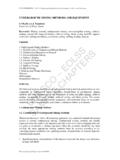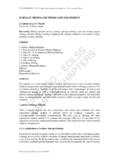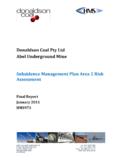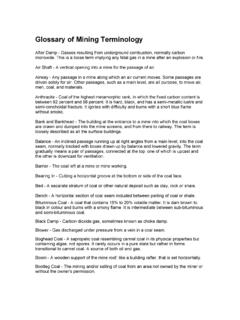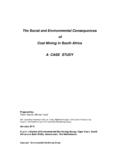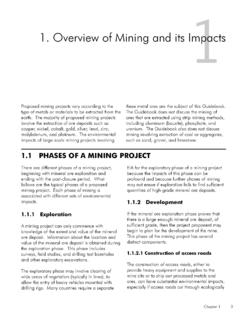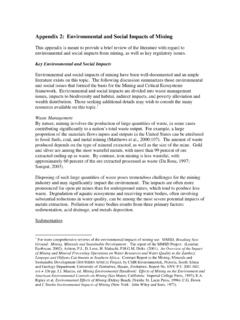Transcription of Coal Mining Methods - EMFI
1 Coal Mining Methods underground Mining Longwall & Room and Pillar Mining Longwall Mining and room-and-pillar Mining are the two basic Methods of Mining coal underground , with room-and-pillar being the traditional method in the United States. Both Methods are well suited to extracting the relatively flat coalbeds (or coal seams) typical of the United States. Although widely used in other countries, longwall Mining has only recently become important in the United States, its share of total underground coal production having grown from less than 5 percent before 1980 to about half in 2007. More than 85 longwalls operate in the United States, most of them in the Appalachian region. In principle, longwall Mining is quite simple (Fig.)
2 1). A coalbed is blocked out into a panel averaging nearly 800 feet in width, 7000 feet in length, and 7 feet in height, by excavating passageways around its perimeter. A panel of this size contains more than 1 million short tons of coal, up to 80% of which will be recovered. In the extraction process, numerous pillars of coal are left untouched in certain parts of the mine in order to support the overlying strata. The mined-out area is allowed to collapse, generally causing some surface subsidence. Extraction by longwall Mining is an almost continuous operation involving the use of self-advancing hydraulic roof supports, a sophisticated coal-shearing machine, and an armored conveyor paralleling the coal face. Working under the movable roof supports, the shearing machine rides on the conveyor as it cuts and spills coal onto the conveyor for transport out of the mine.
3 When the shearer has traversed the full length of the coal face, it reverses direction and travels back along the face taking the next cut. As the shearer passes each roof support, the support is moved closer to the newly cut face. The steel canopies of the roof supports protect the workers and equipment located along the face, while the roof is allowed to collapse behind the supports as they are advanced. Extraction continues in this manner until the entire panel of coal is removed. Fig. 1: Longwall Mining Other underground coal mines are laid out in a checkerboard of rooms and pillars (Fig. 2), and the Mining operation involves cyclical, step by-step Mining sequences. The rooms are the empty areas from which coal has been mined, and the pillars are blocks of coal (generally 40 to 80 feet on a side) left to support the mine roof.
4 Room-and-pillar Mining generally is limited to depths of about 1,000 feet because at greater depths larger pillars are needed, resulting in smaller coal recovery (typically 60% of the coal in the affected area). The continuous version of room-and pillar Mining is the most common, representing more than half of all underground production. In this method, a continuous Mining machine excavates the coal and loads it onto a conveyor or shuttle car in a single step. Despite the term continuous, the machine operates only part of the working time, because after Mining advances about 20 feet, the machine is withdrawn from the face so that roof bolts can be installed to bond the strata and prevent caving. In conventional room-and-pillar Mining , production occurs in five steps: mechanically undercutting the coalbed, drilling holes into the bed for explosives, blasting the coal, loading the broken coal into shuttle cars for delivery to a conveyor, and then bolting the mine roof in the excavated area.
5 To provide a steady flow of coal in a room-and-pillar mine, several stages of Mining occur simultaneously in different rooms. A final phase of Mining termed retreat Mining may be performed to recover additional coal by extracting pillars and allowing the roof to fall. However, this is a complex procedure that requires additional planning. Advantages of Longwall Mining Longwall Mining is a very efficient coal producing technique. Longwall productivity is potentially higher than that of room-and-pillar Mining , because longwall Mining is basically a continuous operation requiring fewer workers and allowing a high rate of production to be sustained. The amount of coal recovered is also Fig. 2: Room and Pillar Mining high, currently averaging 57 percent nationwide but substantially higher in some mines.
6 Room-and-pillar recovery rates are usually lower, but they may approach longwall recoveries if retreat Mining is employed. The longwall system also concentrates miners and equipment in fewer working sections, which makes the mine easier to manage. Safety improves through better roof control and a reduction in the use of moving equipment. This method eliminates roof bolting at the working face to support the mine roof, and it minimizes the need for dusting mine passages with inert material to prevent coal dust explosions. It involves no blasting, with its consequent dangers. It also recovers more coal from deeper coalbeds than does room-and-pillar Mining . The coal haulage system is simpler, ventilation is better controlled, and subsidence of the surface is more predictable.
7 Overall, longwall Mining offers more opportunities for automation. Disadvantages of Longwall Mining Longwall Mining s chief drawback is high capital costs. Costs for equipment and installation are substantially higher than for room-and-pillar Mining . Longwall mines need continuous Mining machines (similar to those used in room-and-pillar mines) to block out panels of coal. Plus, longwall mines need the specialized longwall, with its rugged and very expensive shields, cutters, and conveyors. A large initial capital outlay is required, and there is little immediate return from coal production (apart from the small amounts of coal produced during the development of accessways and the first coal panel. The large front-end investment and deferred revenue generally restrict users of longwall technology to large coal companies.)
8 Longwall Mining is also complex, with many moving parts, all of which must operate as an integrated system. Failure of one part can disrupt the entire operation, delaying production and causing contractual difficulties. Longwall Mining also requires a well-maintained ventilation system because of the large amounts of dust and methane produced. Dust levels often exceed the maximum allowable limit despite the use of advanced dust-control technology. A temporary variance may be required while dust levels are reduced by modifying the coal-cutting sequence or by increasing the air flow across the face. Geologic Limitations Not all coalbeds are suitable for longwall Mining . The technique works best in coalbeds that are extensive, fairly flat-lying, generally uniform in thickness, and free of discontinuities, such as large faults or other geologic features that could interfere with continuous coal extraction.
9 The mine floor must provide a firm base for the moveable roof supports used in longwall Mining . Large aquifers should not overlie the coalbed. Oil and gas wells that penetrate the mine are problematic, because pillars of coal must be left to protect the wells. Ideally, the strata overlying the coalbed should cave behind the roof supports soon after the coal is extracted. If the strata hang up and break into large blocks, the high stresses placed on the roof supports may lock them in place and interfere with their operation. When large sections of hard-to-cave roof strata eventually fall, dangerous working conditions can occur due to violent air blasts, ground vibrations, and related conditions. On the other hand, certain geologic conditions strongly favor longwall Mining over room-and-pillar Mining .
10 In particular, coalbeds deeper than 1000 feet typically must be extracted using longwall Mining . Room-and-pillar Mining generally is not economical at such depths because the very large pillars are required to support the roof, which significantly reduces the amount of coal that can be recovered. Longwall Mining is well suited to deep coalbeds because there is no need to support the roof. In fact, the roof in deep mines is less likely to hang up, thereby reducing the stress on the roof supports. Development of a Longwall Operation The first step in the development, or preparation, of a panel of coal for longwall Mining involves the use of continuous Mining machines to dig entries, or passageways, on three sides of a panel, starting from the main entries of the mine.

